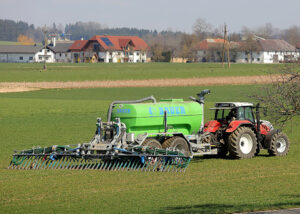Alvaro Garcia
Diarrhea is the first leading cause of calf losses in dairy production systems. Affected calves soon become dehydrated and lose weight, and if not treated accordingly may soon die. A specific drug therapy to treat the causative agent should thus be accompanied by fluid therapy to reestablish the losses of water and minerals.
As a result, oral electrolyte solutions are very important when dealing with severe diarrhea in baby calves, with several types available in the market. These solutions may differ depending on the main intended purpose (i.e. isotonic solutions, electrolytes plus energy sources, etc.), and knowing which one to choose is critical for a prompt recovery.
The wrong fluid therapy can result in unbalances in the body electrolytes or even further losses aggravating the calf’s condition. One thing to consider however is that most milk replacers are made with cheese whey. As a result, these milk replacers have higher concentrations of sodium (up to 2% or 17–80 mmol/L). In addition, they also contain high concentrations of lactose ranging from 140 to 230 mmol/L.
This results in higher overall solids per liter of solution and greater osmolality resulting in more body fluid passing into the intestinal lumen. If in addition sugar (dextrose) and minerals (electrolytes) are added to the solution, then its osmolality can easily exceed 600 mOsm/kg.
It is thus important that calves receiving this treatment have also access to plenty of drinking water so they can reestablish their electrolyte equilibrium. This is not always the case since dairy producers prefer that calves drink replacer rather than water, with the goal of attaining greater growth rates.
A recent experiment (Wilms. et al. 2020) evaluated the efficacy and safety of oral electrolyte solutions included in the milk replacer or in water without access to fresh drinking water. Forty-five male Holstein calves of 16.6 ± 1.6 days of age and 45.4 ± 2.2 kg of body weight went first through an adaptation period of 4 days; those that developed diarrhea within 6 days after the end of the adaptation period were enrolled in the study. Once abnormal fecal scores were detected on day 1 the calves were blocked based on initial body weight, and assigned to the following treatments:
- Control consisting of a small dose of whey power in water and milk replacer
- Oral electrolyte solution in water and milk replacer
The treatments were simultaneously administered for 4 days in milk replacer (2.5 L twice daily) and in water (3 L twice daily) with no additional access to fresh water. Blood samples drawn for analysis and fecal scores (0 = normal; 1 = watery feces) were evaluated during 15 consecutive days. The elasticity of the skin when pinching it (turgor), and the degree of sunken eyes (enophthalmos) were assessed from days 1 to 4 using a 3-level scoring system.
The concentration of oral electrolyte solution was 50 g/L of water and 25 g/L of milk replacer. The concentration of whey powder in the control treatment was 5 g/L of water and of milk replacer.
Diarrhea lasted less in calves that did not receive electrolytes
Compared with control calves, the prevalence of diarrhea was higher in calves that received oral electrolyte solution in days 3, 4, and 5. They also had reduced skin elasticity, more enophthalmos and typical signs of dehydration.
Calves that received the oral electrolyte continued with diarrhea for 4.2 days compared to 2.1 days for those on whey only. The oral electrolyte solution-fed calves had hypernatremia (serum Na+ greater than 145 mmol/L) within 48 h following the initial oral electrolyte solution. This higher sodium concentration was also associated with higher serum chlorine and urea concentrations.
As a result, there was higher serum osmolarity in the calves that received oral electrolyte solution compared to those only on whey. The osmolality of the oral electrolyte solution treatment was 504 mOsm/kg in water and 704 mOsm/kg in milk replacer. This was likely the reason for the osmotic diarrhea, thus further pulling water into the intestinal lumen to maintain the osmotic equilibrium.
Over the 4 monitoring days, 25% of calves receiving oral electrolyte solution had reduced skin elasticity compared with only 9% in the calves on whey only. Also, 23% of the calves fed oral electrolyte solution had enophthalmos with only 6% in those on whey only.
Oral electrolytes caused hypernatremia and higher serum osmolarity
The oral electrolyte solution treatment resulted in hypernatremia within 2 days after the first administration. Recent research has suggested that this hypernatremia can be corrected by calculating the free water deficit as: 4 mL × body weight × desired change in serum Na+ (expressed in mmol/L). For example, a 45-kg calf with serum Na+ concentrations of 160 mmol/L, will need around 3.7 liters of water to normalize serum Na+ concentrations to 140 mmol/L.
The increase in the concentrations of blood metabolites (sodium, chloride, and urea) resulted in higher serum osmolarity in calves fed oral electrolytes (313 mOsm/L) compared with those fed only whey (295 mOsm/L). In addition, calves fed whey only recovered from the diarrhea 2 days before those on oral electrolyte solution.
This led to the conclusion that hypernatremia and hyperosmolality were the culprits rather than dehydration. The results of this experiment suggest that providing sugar and mineral powder mix in milk replacer without access to free drinking water may delay the recovery from diarrhea.
Reference
Wilms, J., Leal, L., Martín-Tereso, J. Short Communication: Hypernatremia in Diarrheic Calves Associated with Oral Electrolyte Administration in Water and Milk Replacer in Absence of Access to Water. J Dairy Sci. 2020 Jun;103(6):5495-5500.
© 2020 Dairy Knowledge Center. All Rights Reserved.











